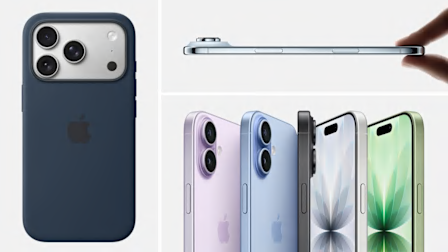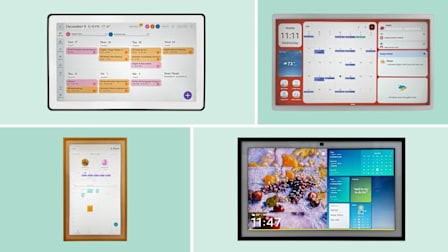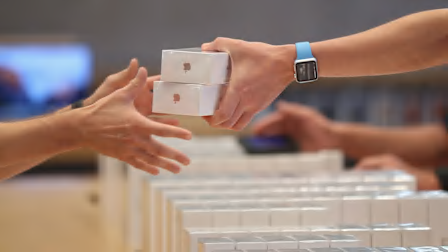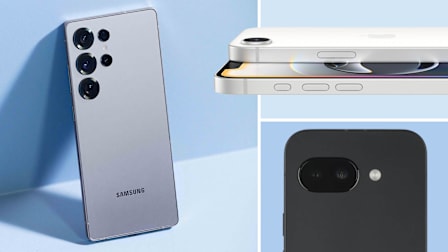iPhone 14 Pro Models With No Notch, Plus More iPhone 14 Upgrades and Prices
Also: The new iPhone Plus lets fans get a Max-sized screen for less money, and safety features include emergency SOS by satellite
Apple introduced its iPhone 14 lineup on Tuesday, saying all four of its new phones will have improved cameras and new safety features, while the top-end versions will also get faster processors, brighter displays, and other upgrades.
The company also showed off the new Apple Watch Series 8 models and a next-generation AirPods Pro.
There are two standard phone models, the iPhone 14 and iPhone 14 Plus, alongside two premium models, the iPhone 14 Pro and iPhone Pro Max.
Safety Features for iPhone 14 Models
Apple emphasized new connectivity and safety features in the new phone lineup.
The new iPhones will no longer have a physical SIM card but will instead rely on eSIM, a software-only alternative. This will allow you to use multiple phone numbers—even from different cellular providers—on one phone.
There’s also a satellite connection. When you’re off the grid, say, hiking in the mountains without a cellular or WiFi connection, you’ll be able to contact emergency services by text message with Emergency SOS. (When you’re in the backcountry, you can also use Find My via satellite to share your location with friends and family.) Apple is providing the service free for two years, starting in November.
The phones also have car crash detection, similar to a feature in the Apple Watch. Should the phone detect an impact like a car crash, the company says, it can notify emergency responders.
Minor Changes to the iPhone 14 and iPhone 14 Plus
The iPhone 14 shares most of the same guts and brains as last year’s model: the same 6.1-inch OLED display, the same stainless steel housing and glass front and back, the same Apple A15 chip, and the same battery. That’s not necessarily a bad thing, because the iPhone 13 performs very well in CR’s lab tests.
For the new and larger iPhone 14 Plus, Apple says it has the best battery life of any iPhone ever. We’ll report back after testing the device.
The main improvements to the iPhone 14 and its larger sibling are to the camera system. They still have a dual-rear camera system with 12-megapixel wide and ultrawide lenses. But the main 12-megapixel wide camera and the front 12-megapixel camera now have larger sensors and faster apertures, which the company says will improve both still and video photography in low-light conditions and help the cameras capture brighter colors. (The phones lack the telephoto lens found on the Pro models.)
Apple has also added autofocus to the front camera, which should come in handy for everything from selfies to video calls and creating TikTok videos.
Both the iPhone 14 and iPhone 14 Plus will be available in black (midnight), white (starlight), blue, purple, and red (product red).
iPhone 14 Pro and Pro Max
Apple has made much bigger and more varied upgrades to the iPhone 14 Pro and 14 Pro Max. They’re worth looking at individually.
Displays and design: The most innovative feature in iPhones this year may be the “Dynamic Island.” Apple swapped the old, much-maligned notch with a pill-shaped cutout that displays notifications. It can expand and change shape to show alerts, for instance when a call is coming in. It’s interactive, so you can tap or swipe to do things like manage a song that’s playing or switch to the home screen.
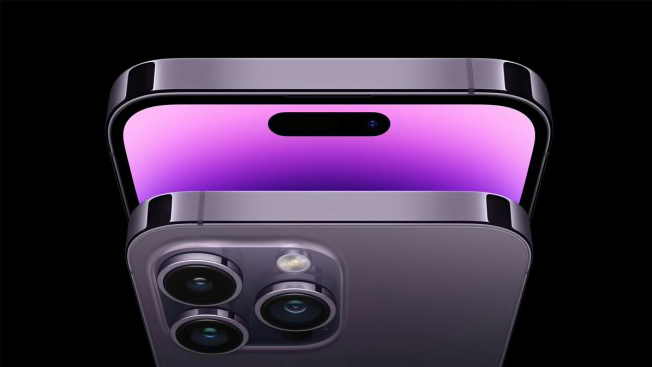
Photo: Apple Photo: Apple
Apple also shrank the display bezels on both phones from previous generations for a teensy bit of extra screen real estate. The phones also have the highest peak brightness of any smartphone, according to the company.
Both phones also can now take advantage of an always-on display. (Like many iPhone innovations of the past, this one has been available on Android phones for several years.) With the always-on display, you can now get glanceable information, like the time or weather, without waking the phone. Worried about battery life? Apple says the phones’ new low-power saving mode and a darker wallpaper will compensate for the always-on power drain.
Processor: Both models run off of Apple’s newest A16 chip, which the company claims is faster and more power-efficient than prior chips. Previously, the company updated all phones in its latest lineup with the new processor, so this is the first time Apple has reserved its newest chip for its Pro devices. It’s unclear whether typical people, doing typical phone things, will notice the difference between this chip and the A15. CR’s testing should shed some light on that.
Cameras: There are a few improvements to the camera system as well. Instead of the 12-megapixel rear wide lens found in the iPhone 13 Pro or 13 Pro Max, the new Pro phones have a 48-megapixel wide lens.
Both the wide and ultrawide lenses have larger sensors, which Apple says will capture brighter shots and more details in low-lighting conditions. CR’s testing will determine whether those changes add up to better photography overall.
The company also touted a new stabilization mode for video called “Action Mode” for smooth video without carrying a smartphone gimbal. And you can record video in “Cinematic Mode” in 4K.
Battery life: Apple didn’t expound on the phones’ battery life, which suggests they might last as long as the 13 series Pro models. (The iPhone 13 Pro runs 40 hours on a charge using CR’s testing protocol; the Pro Max lasts 52.5 hours.)
Color options and storage: Models will be available in new black (space black), silver, gold, and new purple (deep purple). In addition to 128GB, 256GB, and 512GB of storage, you can select a 1TB option, which might appeal most to those who take lots of videos that eat up storage space.
When you shop through retailer links on our site, we may earn affiliate commissions. 100% of the fees we collect are used to support our nonprofit mission. Learn more.





























